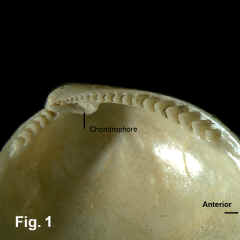|
< Previous family introduction |
|
|||||
 |
Family Nuculidae Nut Shells
|
|||||
|
The Nuculidae, commonly known as nut shells, are part of a relatively small subclass (Protobranchia) of anatomically primitive bivalves. They have small equivalve shells, varying from rounded to somewhat elongate in shape. Their valves are always iridescent internally, but externally are usually uniformly white covered with a smooth periostracum which varies from fawn to dark brown in colour. The periostracum peels off rapidly when the animal dies. A characteristic of the family is the taxodont hinge, with numerous, interlocking, peg-like teeth along the dorsal shell margin on both sides of the umbo (Fig. 1). There is about 170 species occurring worldwide (Huber, 2010, p. 85). Most of them live subtidally down to at least 1000 m in NSW, but down to abyssal depths in some regions. Nuculids are deposit feeders. They burrow in the top layer of soft substrates, using the foot to draw the shell downwards. They sit at an inclined position where water can be drawn in over the gills at the anterior end and ejected at the posterior end of the shell. There are no siphons, and hence no pallial sinus in the pallial line. In contrast to most other bivalves, the gills are used only for gas exchange - extracting oxygen from the water and releasing carbon dioxide produced by respiration back into it - and not for feeding. They are detritus feeders, extending long, thin palp proboscides into the substrate, where particles of food accompanied by extraneous material are attached. The food particles are then consolidated into food strings and, after size sorting, moved to the mouth. Since there are no siphons, so there is no bend in the pallial line to accommodate the retracted siphons as occurs in the other subclasses of bivalves. The family in NSW was revised by W. Bergmans in two publications (1968 and 1978), as listed below. He described several, new, minute species with shells as small as 1 mm in length, and provided excellent drawings of their hinge details. Although the anatomy of the nuculid animals is well known at a family level, the classification of the species is based on shell characters. Characters used include the presence of teeth inside the shell’s dorsal margin, crenulations along the shell’s ventral margin, the strength of external ribbing, and the absence of a pallial sinus. The generic classification used here follows WoRMS (2020). The Australian nuculid fauna has been catalogued by Lamprell & Healy (1998). They listed 23 species, of which 10 are known from NSW. The NSW species vary from minute shells (the majority of which are only about 1 mm in length), known from beach sand sorting and shallow dredgings, up to the only common large species Ennucula obliqua, which lives in the shallow subtidal and below and reaches 15 mm in length. It, and the much smaller Nucula pusilla and N. mayi, are the only common species in shallow water in NSW. The occurrence of the small and minute species is poorly known; they are represented in the Australian Museum collection mainly by the specimens studied by Bergmans in the 1960s and 1970s. Family References Bergmans, W. 1968. A survey of the species of the genus Pronucula in New South Wales. Journal of the Malacological Society of Australia 1(11): 71?78. Bergmans, W. 1978. Taxonomic revision of Recent Australian Nuculidae (Mollusca: Bivalvia). Records of the Australian Museum 31(17): 673?736. Coverage All the species know from NSW are covered here. Identification Notes The most obvious character of the Nuculidae is the taxodont hinge (Fig. 1) with up to 20 teeth on both sides of the umbo, more on the anterior side than the posterior side. Unlike most other bivalves, the umbones are situated behind the midline, and the anterior end of the shell is the longer. The shell’s interior is nacreous. The sculpture of the ventral margin internally may be smooth or strongly crenulate, a character which is used for generic or subgeneric placement. Fig. 1: East of Twofold Bay, NSW in 294-304 m. Hinge detail.
|